Lost at sea 50km from land: Surfer tells of dramatic rescue from trip of a lifetime
It started as a rare surfing trip with mates to an island paradise. What unfolded was an anxious wait by seven blokes in shark infested waters into the night, as a rescue helicopter hovering above them ran low on fuel. SEE THE VIDEO
Bundaberg
Don't miss out on the headlines from Bundaberg. Followed categories will be added to My News.
Riding in his mate’s boat out in the Coral Sea, bouncing off the swell 80km from land, Clark Plaisir was excited about the day ahead.
He and six other surfers from Noosa, many of whom he had met only the day before, were taking a rare surfing trip to Lady Elliot Island, a small coral cay at the southern tip of the Great Barrier Reef.
After driving up to Burnett Heads on Friday, January 12, the group slept on the boat ramp in their swags before setting at 5am on Saturday for the long trip out to the island in the 7m boat owned by Clark’s mate, Joel*.
Aged in their early forties Clark and Joel, who had known each other for years through surfing the breaks around Noosa, were the oldest members of the group, while the rest were aged between 16 and their mid-30s.
With the boat bouncing off the waves on a glorious morning, the young surfers were engaged in animated conversation as Lady Elliot Island began to appear on the horizon.
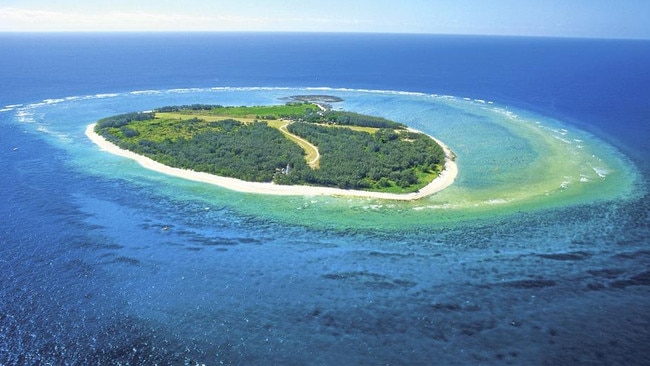
“Everyone was just talking and getting splashed by water, everyone was excited,” Clark said.
“It was beautiful, you’re right in the middle of the ocean and then all of a sudden you come to this perfect little island.
The group spent an enjoyable 5-6 hours surfing, snorkelling and sleeping on the boat moored off the beach.
“It was fun to be doing something different, it was exciting,” Clark said.
“It was great until it wasn’t.”
“We’re in the middle of nowhere, it’s getting dark, there’s got to be sharks”
With the wind picking up through the afternoon the group decided to head back to Burnett Heads around 4pm, and while the going was rougher than on the trip out none of group had any sense that they were taking an inordinate risk.
“There was quite a bit of chop from the wind, it wasn’t a smooth ride,” Clark said.
“But no-one thought we are taking our lives into our own hands.”
The swell picked up through the trip back, with Clark getting “smashed” by the waves crashing over the windows for the front cabin where he was sitting next to Joel.
Around 40 minutes into the trip a strong wave slammed into the side of the boat, causing it to tip over and toss the surfers into the ocean.
“It all happened real quick,” Clark said.
“I had no warning that this is going to happen now, it just happened.
“Next thing I know, we’re all in the water and the boat is upside down.
“And we were still 55 kilometres from land, so it wasn’t really ideal.”
In the “surreal” moments that followed, Joel and another surfer under the water to get the EPIRB from the boat’s cabin, while others gathered together life jackets, food and water.
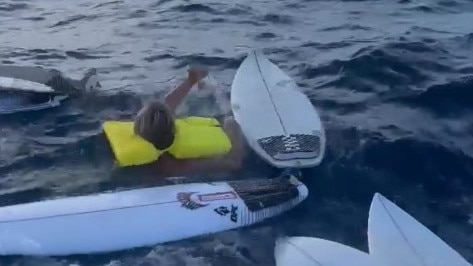
Around 10 surfboards floated to the surface, which the group tied themselves to in case the boat they were clinging on to sank completely.
While no-one panicked, Clark said some dark thoughts played through his mind in the first half-hour, running through dangers of floating in the open ocean with night approaching.
“I just felt like a sitting duck in the water you know,” he said.
“We’re in the middle of nowhere, it’s getting dark, there’s got to be sharks; it’s all I could think about.”
He began to berate himself for taking a risky and self-indulgent trip away from his young family for the weekend, leaving his wife and two young children at home.
“I sort of went really quiet, just thinking I want to see my kids,” Clark said.
“I didn’t feel selfish while I was going up there to go surfing, but then when I was suddenly in the water clinging onto this boat upside down I thought ‘God I wish I’d just stayed home with the kids’.”
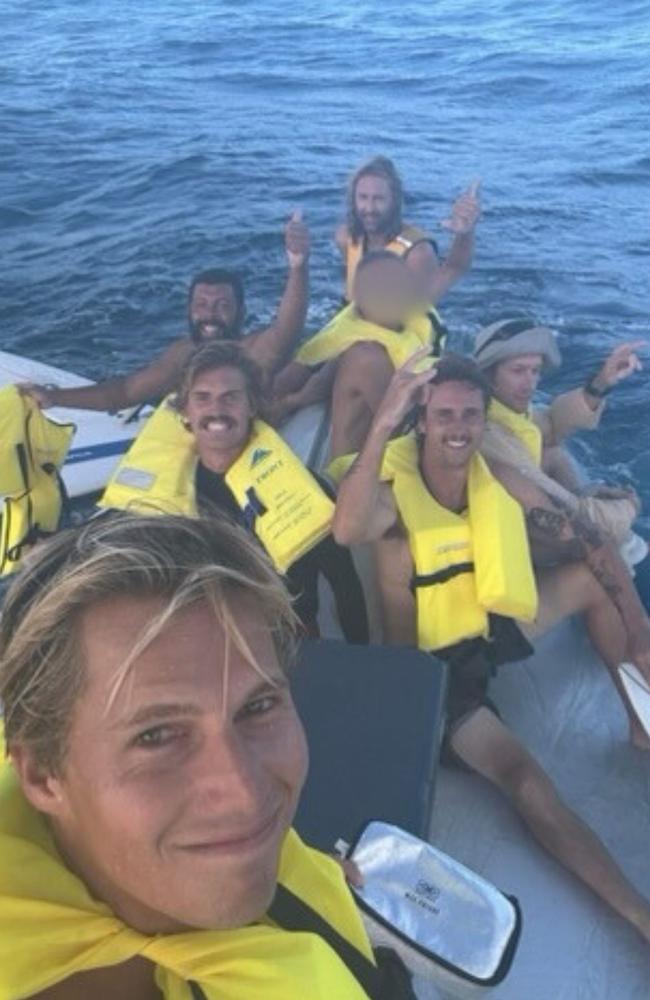
The rescue
The LifeFlight Bundaberg base received the distress call from Joel’s EPIRB at 5.23pm and immediately dispatched a chopper, which spotted the men around 6.02pm.
“All of a sudden our spirits have lifted,” Clark said.
“We thought we’re going to be winched up, we’re going to be out of here soon.
“But it wasn’t as quick as we first thought.”
With the LifeFlight chopper having a maximum capacity of three, the crew dropped down a life raft and radio and co-ordinated with Volunteer Marine Rescue in Bundaberg to rescue the group by boat.
VMR Bundaberg was contacted by the Queensland Police Service rescue co-ordinator at 5,40pm, and dispatched their Bundy Rescue 2 vessel 20 minutes later.
The LifeFlight chopper hovered overhead, staying with the surfers and serving as a location indicator for the VMR crew for around an hour before heading back to base when it ran low on fuel.
Clark said the LifeFlight crew were superb in communicating with the group via the radio, keeping them apprised of the status of the rescue and what they should expect.
With the chopper leaving at around 7pm, well after nightfall, the group had to wait around an hour in the dark before the VMR vessel arrived.
“I’m glad there were seven of us, because we were trying to joke around and we were all talking,” Clark said.
“It wasn’t the most comfortable situation; it just felt like a movie, it just didn’t feel real.”
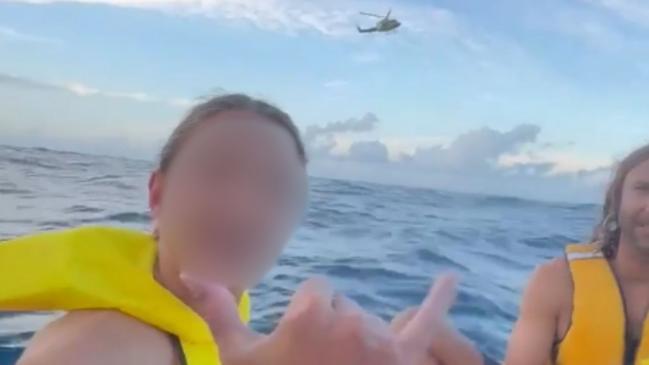
One of the surfers, who somehow was able to hang on to their mobile phone, took photos and short video clips of the group’s banter.
“Yeah, I’d go back again,” one of them said, sparking laughter from the others.
“Everyone was really calm, I think everyone was trying to stay positive because no one was negative,” Clark said.
“Thinking about it now, it’s like ‘God if someone was stressing and really scared it would have been a different story.”
The VMR vessel began to be visible around 7.30pm before it reached the group 20 minutes later.
“We could see this little green light … getting closer and closer, so that was getting everyone excited,” Clark said.
“I just wanted to get out of the water, I was like ‘just let me out of the bloody ocean’.”
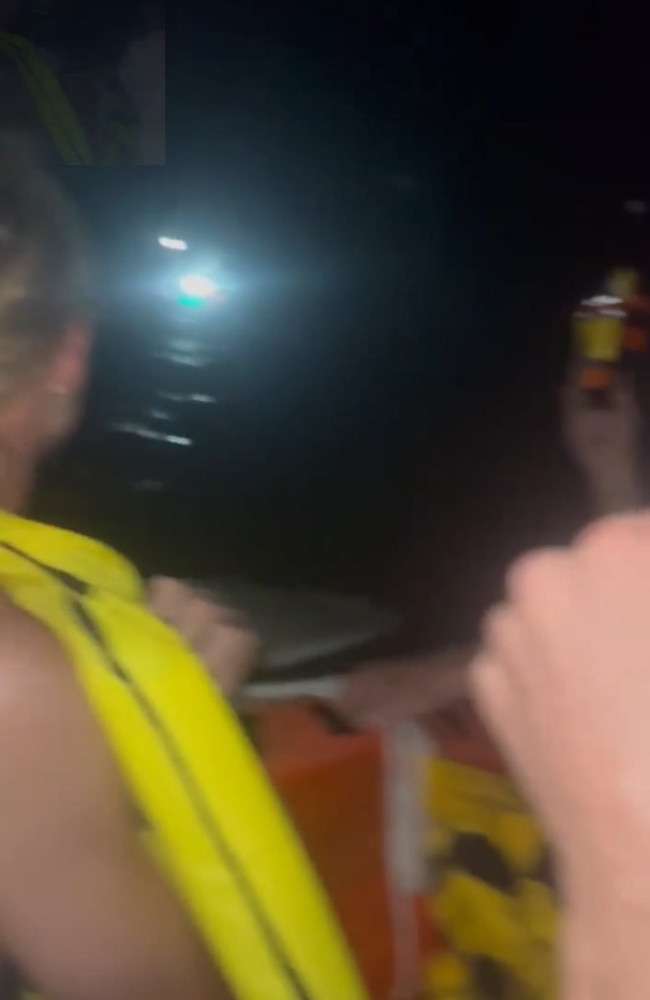
Clark said the surfers had already decided that the youngest of the group, a 16 year-old boy, would be the first to go to safety, whether in the boat or winched up in the chopper.
“Not that anything was wrong with him, but that was just what we did,” he said.
After clambering onto the VMR vessel, some with the assistance of the crew, Clark said it was a huge relief to the group to finally be out of the water.
“We were just on a big boat, that felt really good,” he said.
The VMR volunteers were “awesome”, Clark said, checking them over and remaking on how lucky they were not to be injured.
VMR Bundaberg public relations officer Graham Kingston said the group were in “surprisingly good condition”, with a capsize at speed usually resulting in broken bones or bleeding wounds.
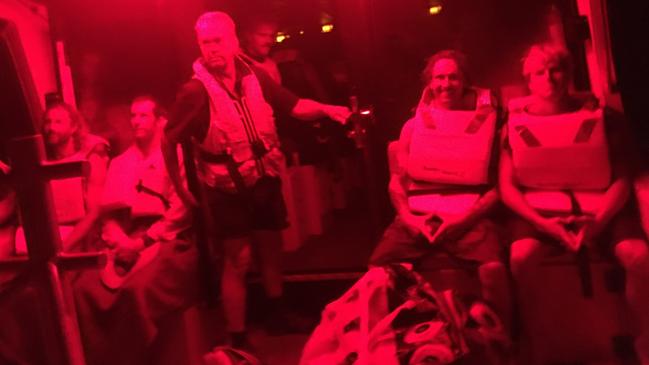
“If someone was bleeding from hitting the corner on the boat or something, there would have been fish and sharks swimming around, so we were very lucky,” Clark said.
Back on dry land
After a four hour trip later the VMR vessel returned to Burnett Heads at 10.50pm, where the surfers could finally step onto dry land although Clark said he still had his “sea legs” for around 20 minutes.
“Once I jumped onto the boat ramp it felt like I was still bouncing around in the water,” he said.
“I had my sea legs big time, I’ve never had them like that before.”
The group had a short conversation with two police officers who were waiting at the boat ramp, and received a quick medical assessment from ambulance officers who gave them towels and blankets.
After collecting the spare keys to their cars from one of the surfer’s wives, who had driven up from Noosa, the group settled down for one more night under the stars sleeping in the swags on the boat ramp.
“I slept very well … like a dead person,” Clark said.
The next morning Clark drove back with another surfer with children, with the conversation fading the closer they got to home.
“The last half-hour of the drive back, he was just looking forward to seeing his wife and kids,” Clark said.
“It was hitting us at different times.”
After reuniting with his family, Clark said his wife seemed to be holding up well and his five year-old son had some words of admonition for him.
“I enjoyed giving them a hug,” Clark said.
“My son told me ‘you’re not allowed to go surf there again Dad’.”
Around an hour after arriving home, Clark’s wife broke down, reliving all the worst fears she had also been struggling with over the past 24 hours.
“We wouldn’t be here if it wasn’t for them, they’re heroes”
The group of friends, now bonded for a lifetime from their experience, were in regular communication over the following week, reflecting on how lucky they were and considering the many worse alternative outcomes.
“For a week were saying ‘imagine if this happened or that happened’,” Clark said.
“But then we realised that was pointless, because it didn’t happen.”
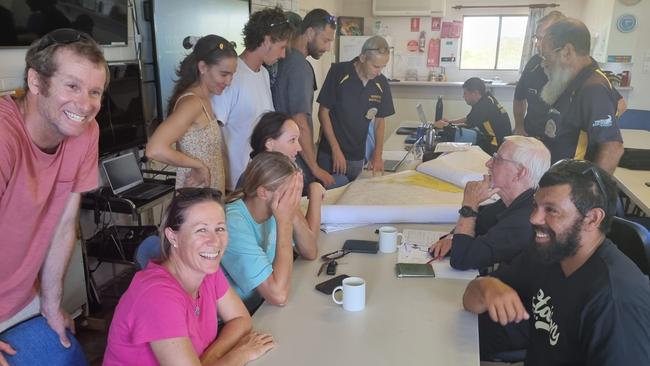
Clark said he has “been surfing heaps” since the incident, but has been pressing on anyone with a boat to take the proper precautions and ensure they have an EPIRB installed.
Mr Kingston said while Joel’s boat complied with Australian Maritime Safety Authority regulations in having an EPIRB, new regulations require the installation of float-free EPIRBs on vessels less than 12 meters, which may have avoided the surfers needing to take risks in diving under the water to retrieve it.
Joel, who had remained in contact with one of the LifeLight crew members, arranged for the group to return to Bundaberg to express their gratitude to the people to whom they owed so much.
While speaking to the LifeFlight and VMR crews over lunch and a tour of their bases, the group learnt that people rarely come back to pay a visit after a rescue.
“The VMR guys do training and give up big chunks of their weekend, just in case something happens like what happened to us,” Clark said.
“We wouldn’t be here if it wasn’t for them, they’re heroes.”
*A pseudonym has been used due to a request to protect Joel’s identity.
MORE NEWS:
Childcare centre fined more than $34k for ‘multiple offences’
‘Human right’: MP blasts govt over ‘false promises’ in housing crisis





